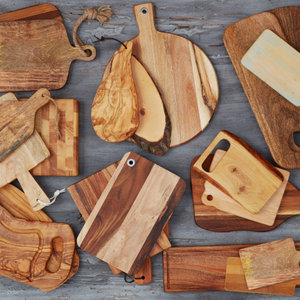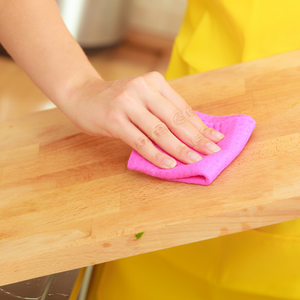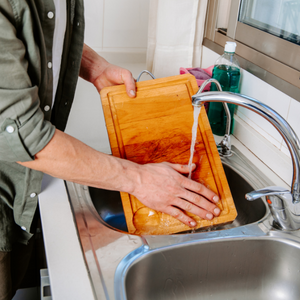A wooden cutting board is a beautiful and functional addition to any kitchen. But like any other kitchen item, it needs to be properly cared for to keep it looking and performing its best. In this detailed guide, we go over numerous tips on how to clean a wooden cutting board so that it lasts you for years to come.
3 Ways To Clean A Wooden Cutting Board
Wooden cutting boards see a lot of action in the kitchen. They're used for chopping vegetables, slicing meat, and several other ingredients. Over time, cutting boards may become stained and discolored. To keep them looking their best, it's important to clean them regularly. Here are three effective methods for cleaning a wooden cutting board.
With Soap & Water
The simplest way to clean a wooden cutting board is with soap and water. Just give it a good scrub with a sponge or brush and use hot, soapy water. Be sure to wash both sides of the board and rinse it thoroughly.
With Bleach & Water
If your cutting board has food stains, you can use a bleach and water solution to clean it. Just add one tablespoon of unscented, liquid chlorine bleach to one gallon of water. Either submerge the board in the bleach solution or soak the entire surface of the board with the solution. Let it sit for a few minutes so that it has time to kill any bacteria on the board. Then, rinse it thoroughly with warm water and dish soap to remove any lingering bleach odor.
With Vinegar & Water
Cleaning a wooden cutting board with vinegar is a safe and effective way to remove bacteria and stains. Vinegar is a natural disinfectant that helps restore the wood's natural shine. To clean your cutting board with vinegar, simply mix one part white vinegar with four parts water in a bowl. Then, apply the vinegar mixture to the board and let it sit for a few minutes before rinsing and wiping it down.
How To Dry A Wooden Cutting Board
A critical step in caring for a wooden board is to dry it properly after each use. The best way to do this is to dry it with a clean dish towel or paper towel. Once it's dry, you can place it upright on your counter, dish rack, or in a cool, dark place. You want to avoid placing the butcher board in direct sunlight, which can cause the wood to crack.
How To Sanitize A Wooden Cutting Board
It's important to sanitize your wooden cutting board regularly, especially if it is used for cutting raw meat. If you do not frequently sanitize your chopping board, it can lead to bacteria building up and cross-contamination.
To sanitize your wood chopping board, use a solution of one tablespoon of unscented, liquid chlorine bleach in one gallon of water. Just soak the board in the solution for a few minutes, then rinse it well with warm water.
How To Remove Odors From A Wooden Cutting Board
If your cutting board is starting to smell, there is an easy way to freshen it up. You can make a paste out of kosher salt and lemon juice. Simply sprinkle the board with kosher salt, squeeze lemon juice over the salt, and use the cut side of the lemon to rub the mixture on the board. Let the paste sit on the board for at least five minutes, then rinse it off and dry it.
How To Season A Wooden Cutting Board
Seasoning a wooden cutting board is a simple and effective way to help prolong its life. Seasoning the board will create a barrier that helps to protect the wood from water damage, staining, and bacteria. To season a wooden chopping board, simply rub it down with a food-grade mineral oil or beeswax. Allow the oil to sit on the board's surface for a few hours, then wipe off any excess with a clean cloth.
How To Repair A Damaged Wooden Cutting Board
If your cutting board is damaged, there are a couple of easy ways to repair it. For minor scratches and gouges, you can simply rub the board's surfaces with food-grade mineral oil or beeswax.
For deep cuts or large gouges, you will need to complete several rounds of sanding. It's recommended to start with coarse-grit sandpaper and work toward a finer-grit one. It's essential to sand both sides of your board, even if one side doesn't have as much damage as the other, so that each surface receives the same treatment. Sanding both sides makes the board less prone to warping. After sanding a wooden chopping board, you should oil it to help smoothen the surface and maintain its appearance.
Mistakes To Avoid When Washing A Wooden Cutting Board
With proper care, your cutting board can last for many years. However, there are some common mistakes that people make when cleaning their wooden cutting boards that can damage the board and shorten its lifespan. Here are some things to avoid when washing your wooden butcher board:
- Don't lay a wet cutting board on its surface as it can trap and lock in excess moisture, leading to bacteria buildup.
- Don't let the board soak in water for extended periods of time because it can cause swelling and cracking.
- Don't put the board in the dishwasher as it can cause the wood to swell, which separates fibers and creates cracks.
- Don’t let stains go untreated because they become more challenging to remove over time.
- Don't expose the board to excessive moisture or heat as it can cause the wood to warp.
Keep Your Cutting Board Looking New!
To ensure your wooden chopping board maintains its exceptional appearance, be sure to regularly clean it, season it before each use, and avoid exposing it to excessive moisture or heat. With some tender love and care, your cutting board will be a kitchen staple for years to come.









